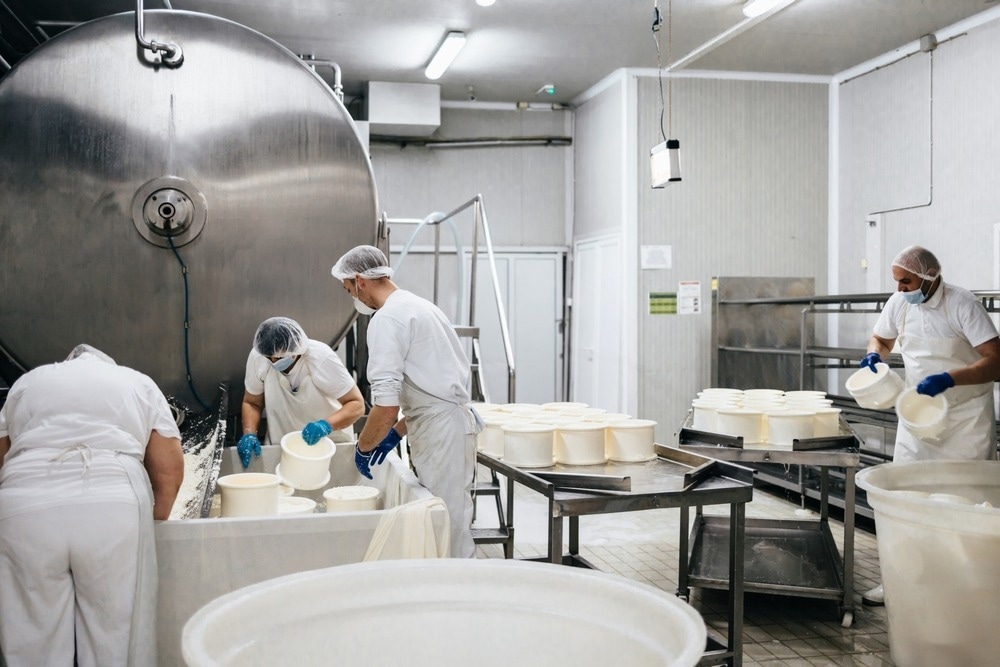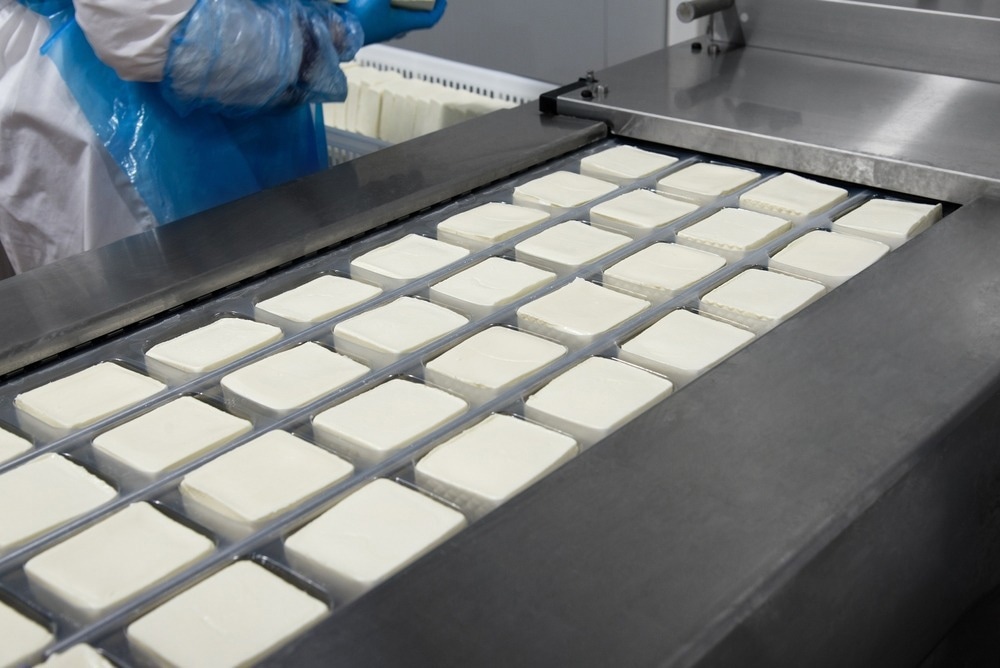Cheesemaking is a delicate process that requires precise control over various factors, including humidity. The importance of monitoring humidity in industrial cheesemaking cannot be overstated, as it directly impacts the quality, texture, and flavor of the final product. This article explores why humidity monitoring is essential in cheesemaking, the challenges faced by the industry, and commercial examples.

Image Credit: DuxX/Shutterstock.com
How is Cheese Made?
Cheesemaking is a complex biochemical process involving the coagulation of milk proteins, the formation of curds, and subsequent aging to develop the desired flavor and texture. Cheese has many varieties that are determined by the combination of processing, ingredients, and characteristics. The process of making cheese also varies depending on the type of desired cheese; however, there are general steps and ingredients that are common in all cheesemaking procedures.
Milk is standardized and heated or pasteurized to remove the unwanted microorganisms and then cooled to 32 °C to develop the environment for the bacteria to grow and begin fermentation. After that, the rennet is added and kept undisturbed for approximately 30 minutes to form a firm coagulum until it reaches a 6.4 pH level. The curd is then cut and heated to 38 °C, separating the curd for the whey to form curd mats. These mats go through cheddaring by cutting them into portions, pilling them on each other, and flipping them periodically.
Some parts of the procedure vary depending on the type of cheese made. For instance, for cheddar cheese, the smaller curd pieces are sprinkled with dry salt, whereas for mozzarella, the curd is developed into loaves and placed into brine. These slated curd pieces are put into cheese hoops and compressed into blocks, forming cheese.
The Significance of Humidity in Cheesemaking
Humidity plays a pivotal role at various stages of cheesemaking, influencing microbial activity, moisture content, and the quality of the cheese. For instance, humidity levels directly affect the growth of microorganisms, including bacteria and molds, which are essential for the fermentation and ripening stages of cheesemaking.
Monitoring humidity is also crucial for maintaining the ideal moisture content in the cheese to avoid dryness or excessive moisture, which is essential to achieve the desired texture. Moreover, humidity influences enzymatic reactions that contribute to developing flavor compounds in cheese. Therefore, the overall quality of the cheese is highly dependent on the humidity controls of the cheesemaking process.
The Role of Humidity Sensors in Cheesemaking
Humidity sensors have improved the way cheesemakers monitor and control the production environment. Automated humidity sensors provide real-time data on the moisture levels within the cheesemaking facility, which is instrumental in maintaining the ideal conditions for microbial activity, moisture content, and flavor development, allowing for proactive adjustments and reducing the risk of deviations in product quality.
Rotronic, a brand of Process Sensing Technologies (PST), has developed humidity sensors, including Hygroflex5 - HF5 - HVAC Transmitters and Hygrolog - HL-NT3-D - High-end Data Logger that provide high temperature and humidity sensing for cheesemaking and storage. Rotronic sensors contribute to cheese quality control, preventing issues such as moisture-related spoilage and texture variations.
A distinctive advantage of using Rotronic humidity sensors is that their thick film provides high ammoniac resistance. This advantage is significant since some cheeses emit ammonia gas during maturation, leading to increased drift in most humidity probes.

Image Credit: Svechkova Olena/Shutterstock.com
Recent Studies
In a recent study, researchers investigated the impact of temperature and relative humidity (RH) on the ripening process of artisanal goat cheeses, specifically Picodon cheeses. The study focused on 16 physicochemical characteristics and 19 sensory attributes throughout the 12-day ripening period.
The findings revealed a strong dependence of physicochemical and sensory characteristics on RH, with significant effects on core pH, lactate consumption, dry matter content, and hardness. An increase in RH from 88% to 98% led to notable changes in cheese characteristics, resulting in a perception of creaminess and moist texture. Temperature variations showed fewer effects, but an increase from 10 °C to 14 °C intensified the impact of RH. The study emphasizes the importance of controlling RH for achieving optimal ripening conditions and suggests practical strategies for enhancing the quality of artisanal goat cheeses.
Challenges in Industrial Cheesemaking
Industrial-scale cheesemaking presents unique challenges compared to traditional artisanal methods due to the sheer volume of production and required consistency. Humidity fluctuations can lead to inconsistencies in product quality, resulting in financial losses and a compromised brand reputation. Similarly, ensuring uniformity across batches is a significant challenge in large-scale operations since humidity differentials between batches can lead to variations in taste, texture, and appearance. To address these issues, industrial cheesemakers turn to advanced automated monitoring systems that provide real-time data, which allows them to make precise adjustments and maintain consistency.
Conclusion
In conclusion, humidity monitoring is crucial in the intricate process of cheesemaking, directly impacting the quality, texture, and flavor of the final product. Advanced humidity sensors, like Rotronic’s Hygroflex5 - HF5 - HVAC Transmitters and Hygrolog - HL-NT3-D - High-end Data Logger, have revolutionized cheesemaking by providing real-time data, enabling proactive adjustments and ensuring compliance with industry standards.
References and Further Reading
Abdelnour, A., et al. (2019). Design of RFID sensor tag for cheese quality monitoring. In 2019 IEEE MTT-S International Microwave Symposium (IMS). IEEE, pp. 290-292.doi.org/10.1109/MWSYM.2019.8700769
Cheese. Measurement Solutions - Humidity, Temperature, CO2 and Differential Pressure Measurement. Available at https://www.rotronic.com/en/humidity_measurement-feuchtemessung-mesure_de_l_humidite/cheese-kaese-mr
Leclercq-Perlat, M. N., et al. (2019). Physicochemical and sensory evolutions of the lactic goat cheese Picodon in relation to temperature and relative humidity used throughout ripening. Journal of Dairy Science. doi.org/10.3168/jds.2018-15958
The role of humidity and temperature in cheesemaking. Omni Sensors & Transmitters. Available at https://sensorsandtransmitters.com/the-role-of-humidity-and-temperature-in-cheesemaking/
Disclaimer: The views expressed here are those of the author expressed in their private capacity and do not necessarily represent the views of AZoM.com Limited T/A AZoNetwork the owner and operator of this website. This disclaimer forms part of the Terms and conditions of use of this website.